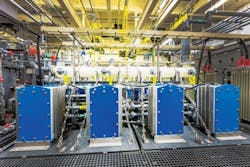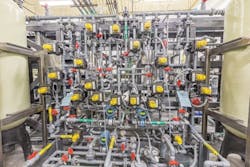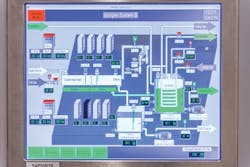About the author: Lauren Baltas is assistant editor for W&WD. Baltas can be reached at [email protected] or 847.391.1019.
- Name: John M. Asplund Wastewater Treatment Facility
- Location: Anchorage, Alaska
- Size: 58 mgd
- Infrastructure: Headworks, grit removal, primary clarification, scum concentration, solids handling, incineration, disinfection, plant effluent system
The gears are always turning at the John M. Asplund Wastewater Treatment Facility (WWTF)—literally and figuratively. Since its construction in 1973, the Asplund WWTF is always finishing, completing or planning an upgrade, the most recent being a disinfection upgrade project.
Double Trouble
Located in Anchorage, Alaska, the Asplund WWTF is owned by the Anchorage Water and Wastewater Utility (AWWU), a department of the municipality of Anchorage.
The Asplund WWTF is a conventional primary treatment plant rated for an average flow of 58 million gal per day (mgd), but currently operating at approximately 30 mgd. The facility treats wastewater from the Anchorage Bowl region and processes sludge from the nearby Eagle River and Girdwood WWTFs.
The treatment process includes raw wastewater intake, headworks, grit removal and primary clarification, which includes scum concentration, solids handling and incineration. The wastewater travels through disinfection and the plant effluent system, eventually ending up in the Cook Inlet outside Anchorage. The gravity-fed process takes approximately five hours, and all processing is completed at the facility, except for the disposal of ash, grit and screenings, which are sent to a landfill.
The WWTF underwent a major expansion in the 1980s, nearly doubling its capacity. Now it serves approximately 300,000 residents in the municipality, but its total service population is more than 400,000, as it also treats septage hauled from onsite residents in the municipality, leachate from the municipal landfill, and domestic septage from systems outside the municipal boundary in South Central Alaska.
While it is rated for a 58-mgd flow, the Asplund WWTF currently operates at approximately 30 mgd.
Safety First
In order to maintain regulatory compliance, the WWTF always has an upgrade on deck. “In my almost 13 years with AWWU, there has been one project or another going on at Asplund every year,” said Stephen Nuss, engineering division director for AWWU.
After developing its U.S. Environmental Protection Agency Risk Management Plan, the Asplund WWTF discovered that thousands of local residents could potentially be affected by an accidental or uncontrolled release of chlorine gas from the plant. Also, the shipment of chlorine gas raises security concerns, relating to the growing necessity to protect toxic chemicals from misuse. To rectify the issue, in 2014, the AWWU broke ground on a project to discontinue using chlorine gas for effluent disinfection and use hypochlorination with high-strength sodium hypochlorite generated on site in its absence.
In 17 months, the 10,000-sq-ft phased renovation and installation of the new onsite equipment was completed, and the facility was brought back up to code.
The facility’s processing is gravity fed and takes approximately five hours to complete.
Step by Step
Currently, the facility is “overhauling” its screens, with another project to improve its grit handling process on the horizon. In addition, the facility seeks to eventually reduce its water intake from the AWWU system.
“The Asplund WWTF is the largest water customer in our system,” Nuss said. “We use a significant amount of water to both clean our screens and also scrub our emissions from our incinerator. We are looking at ways to reduce dependency on piped water from the water system by using increases in groundwater.”
But current upgrades do not negate future challenges. The facility foresees potential concerns that will require upgrades in the future.
The incinerator is due for an upgrade, and the combination of increasing natural gas costs and tightening air permit requirements suggest that an improvement in sludge handling is not far away.
The facility operates under a Clean Water Act (CWA) Section 301(h) modification as a primary treatment facility discharging to a marine environment and utilizing incineration as the solids handling process. It meets published biological oxygen demand and total suspended solids removal rates almost to the standard of a secondary treatment facility.
Nuss and other facility officials fear the loss of the CWA 301(h) designation. “If legislation was enacted that removed primary treatment as an option, and we had to make upgrades to go to secondary treatment, it would be extremely costly for our customers,” he said. “We continue to work hard to achieve better quality discharges than are required by our permit. We are proud of that, and we want to continue to meet those rates.”


